Twelfth Dynasty of Egypt | |||||||||
|---|---|---|---|---|---|---|---|---|---|
| 1991 BC – 1802 BC | |||||||||
 | |||||||||
| Capital | Thebes, Itjtawy | ||||||||
| Common languages | Egyptian language | ||||||||
| Religion | ancient Egyptian religion | ||||||||
| Government | Absolute monarchy | ||||||||
| Historical era | Middle Kingdom of Egypt | ||||||||
• Established | 1991 BC | ||||||||
• Disestablished | 1802 BC | ||||||||
| |||||||||
| Periods and dynasties of ancient Egypt |
|---|
|
All years are BC |
The Twelfth Dynasty of ancient Egypt (Dynasty XII) is a series of rulers reigning from 1991–1802 BC (190 years),[citation needed] at what is often considered to be the apex of the Middle Kingdom (Dynasties XI–XIV). The dynasty periodically expanded its territory from the Nile delta and valley South beyond the second cataract and East into Canaan.
The Twelfth Dynasty was marked by relative stability and development. It has a notably well recorded history for the period. Its first pharaoh was Amenemhat I and its final was Sobekneferu.
The chronology of the Twelfth Dynasty is the most stable of any period before the New Kingdom. The Turin Royal Canon gives 213 years (1991–1778 BC). Manetho stated that it was based in Thebes, but from contemporary records it is clear that the first king of this dynasty, Amenemhat I, moved its capital to a new city named "Amenemhat-itj-tawy" ("Amenemhat the Seizer of the Two Lands"), more simply called, Itjtawy.[1] The location of Itjtawy has not been discovered yet, but it is thought to be near the Fayyum, probably near the royal graveyards at el-Lisht.[2]
The order of its rulers of the Twelfth Dynasty is well known from several sources: two lists recorded at temples in Abydos and one at Saqqara, as well as lists derived from Manetho's work. A recorded date during the reign of Senusret III can be correlated to the Sothic cycle,[3] consequently, many events during this dynasty frequently can be assigned to a specific year. However, scholars now have expressed skepticism in the usefulness of the referred date, due to the fact that location affects observation of the Sothic cycle.[4]
Egypt underwent various developments under the Twelfth Dynasty, including the reorganization of the kingdoms administration and agricultural developments in the Fayyum. The Twelfth Dynasty was also responsible for significant expansion of Egyptian borders, with campaigns pushing into Nubia and the Levant.[citation needed]
The Twelfth Dynasty is often considered the apex of Egypt's Middle Kingdom. The Middle Kingdom spans the Eleventh, Thirteenth, and Fourteenth dynasties, but some scholars only consider the 11th and 12th dynasties to be part of the Middle Kingdom.[citation needed]
| Nomen (personal name) | Prenomen (throne name) | Horus-name | Image | Date | Pyramid | Queen(s) |
|---|---|---|---|---|---|---|
| Amenemhat I | Sehetepibre | Wehemmesu |  |
1991 – 1962 BC | Pyramid of Amenemhet I | Neferitatjenen |
| Senusret I (Sesostris I) | Kheperkare | Ankhmesut |  |
1971 – 1926 BC | Pyramid of Senusret I | Neferu III |
| Amenemhat II | Nubkhaure | Hekenemmaat | 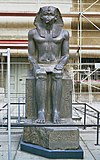 |
1929 – 1895 BC | White Pyramid | Kaneferu Keminub? |
| Senusret II (Sesostris II) | Khakheperre | Seshemutawy | 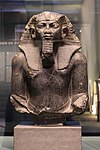 |
1897 – 1878 BC | Pyramid at El-Lahun |
Khenemetneferhedjet I Nofret II Itaweret? Khnemet |
| Senusret III (Sesostris III) | Khakaure | Netjerkheperu |  |
1878 – 1839 BC | Pyramid at Dahshur | Meretseger Neferthenut Khnemetneferhedjet II (Weret) Sithathoriunet |
| Amenemhat III | Nimaatre | Aabau |  |
1860 – 1814 BC | Black Pyramid; Pyramid at Hawara | Aat Hetepi Khenemetneferhedjet III |
| Amenemhat IV | Maakherure | Kheperkheperu |  |
1815 – 1806 BC | Southern Mazghuna pyramid (conjectural) | |
| Sobekneferu | Sobekkare | Merytre |  |
1806 – 1802 BC | Northern Mazghuna pyramid (conjectural) |
Known rulers of the Twelfth Dynasty are as follows:[5]
This dynasty was founded by Amenemhat I, who may have been vizier to the last king of Dynasty XI, Mentuhotep IV. His armies campaigned south as far as the Second Cataract of the Nile and into southern Canaan. As a part of his militaristic expansion of Egypt, Amenemhat I ordered the construction of multiple military forts in Nubia.[6] He also reestablished diplomatic relations with the Canaanite state of Byblos and Hellenic rulers in the Aegean Sea. He was the father of Senusret I.
For the first ten years of his reign, Senusret I ruled as a coregent alongside his father, Amenemhat I. He continued his fathers campaigns into Nubia, expanding Egyptian control to the Third Cataract of the Nile.[6] In addition to pursuing militaristic expansion, Senusret I was also responsible for internal growth within Egypt. As king, he initiated a considerable amount of building projects across Egypt, including pyramids in Lisht, a temple at Karnak and oversaw the renovation of the kingdoms major temples.[4]
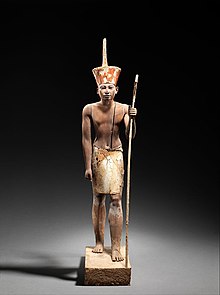
Unlike his predecessors, Amenemhat II was king during a time of peace. Under his reign, trade boomed with other states in Asia, the Mediterranean, and Africa. He built his mortuary complex near Memphis at Dahshur.[6]
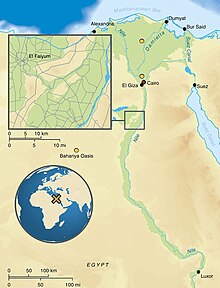
Senusret II also reigned during a time of peace. He was the first king to develop the Fayyum Basin for agricultural production. This development was complex, requiring the digging of several canals and the draining of a lake in order to maximize the Fayyum’s agricultural output. The Middle Kingdom development of the Fayyum later became the basis for the Ptolemaic and Roman efforts that turned the region into the bread basket of the Mediterranean.[6]


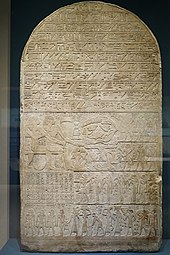
Finding Nubia had grown restive under the previous rulers, Senusret sent punitive expeditions into that land. As a part of his effort to suubdue Nubia, he ordered the construction of several new fortresses as well as the expansion of existing ones along the border with Nubia.[8] He also sent an expedition into the Levant. Senusret III's military career contributed to his prestige during the New Kingdom, as he was regarded as a warrior king and even revered as a god in Nubia.[4] One of Senusret III’s significant internal developments was the centralization of administrative power in the kingdom, which replaced the nome system with three large administrative districts that encompassed all of Egypt.[6]
Senusret's successor Amenemhat III reaffirmed his predecessor's foreign policy. However, after Amenemhat, the energies of this dynasty were largely spent, and the growing troubles of government were left to the dynasty's last ruler, Sobekneferu, to resolve. Amenemhat was remembered for the mortuary temple at Hawara that he built.
Amenemhat IV succeeded his father, Amenemhat III, and ruled for approximately nine years. At the time of his death, Amenemhat IV had no apparent heir, leading to Sobekneferu’s ascension to the throne.
Sobekneferu, a daughter of Amenemhat III, was the first known woman to become king of Egypt.[4] She was left with the unresolved governmental issues that are noted as arising during her father's reign when she succeeded Amenemhat IV, thought to be her brother, half brother, or step brother.[9] Upon his death, she became the heir to the throne because her older sister, Neferuptah, who would have been the next in line to rule, died at an early age. Sobekneferu was the last king of the twelfth dynasty. There is no record of her having an heir. She also had a relatively short nearly four year reign and the next dynasty began with a shift in succession, possibly to unrelated heirs of Amenemhat IV.[10]
Several famous works of Egyptian literature originated from the 12th Dynasty. Perhaps the best known work from this period is The Story of Sinuhe, of which papyrus copies dating as late as the New Kingdom have been recovered.[11]
Some of the existing literature pertaining to the 12th Dynasty are propagandistic in nature. The Prophecy of Neferti establishes a revisionist account of history that legitimizes Amenemhat I’s rule. Written during the reign of Amenemhat I, described a sage’s prophecy given to the 4th Dynasty King Snefru that predicted a destructive civil war. It writes that the sage, Neferti, prophesied that a great king named Ameny (Amenemhat I) would lead a united Egypt out of this tumultuous period.[11] The work also mentions Amenemhat I's mother being from[12] the Elephantine Egyptian nome Ta-Seti.[13][14][15][16][17][18][19][20] Many scholars in recent years have argued that Amenemhat I's mother was of Nubian origin.[21][22][23][24][25][26][27]
Other known works attributed to the 12th Dynasty include: